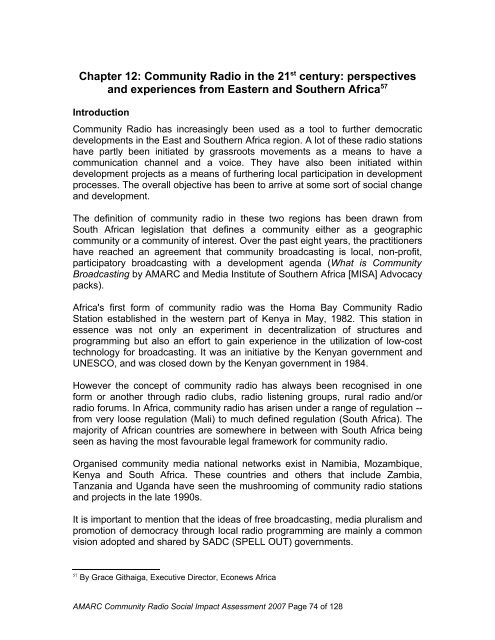Removing Barriers, Increasing Effectiveness - amarc
Removing Barriers, Increasing Effectiveness - amarc
Removing Barriers, Increasing Effectiveness - amarc
Create successful ePaper yourself
Turn your PDF publications into a flip-book with our unique Google optimized e-Paper software.
Chapter 12: Community Radio in the 21 st century: perspectivesand experiences from Eastern and Southern Africa 57IntroductionCommunity Radio has increasingly been used as a tool to further democraticdevelopments in the East and Southern Africa region. A lot of these radio stationshave partly been initiated by grassroots movements as a means to have acommunication channel and a voice. They have also been initiated withindevelopment projects as a means of furthering local participation in developmentprocesses. The overall objective has been to arrive at some sort of social changeand development.The definition of community radio in these two regions has been drawn fromSouth African legislation that defines a community either as a geographiccommunity or a community of interest. Over the past eight years, the practitionershave reached an agreement that community broadcasting is local, non-profit,participatory broadcasting with a development agenda (What is CommunityBroadcasting by AMARC and Media Institute of Southern Africa [MISA] Advocacypacks).Africa's first form of community radio was the Homa Bay Community RadioStation established in the western part of Kenya in May, 1982. This station inessence was not only an experiment in decentralization of structures andprogramming but also an effort to gain experience in the utilization of low-costtechnology for broadcasting. It was an initiative by the Kenyan government andUNESCO, and was closed down by the Kenyan government in 1984.However the concept of community radio has always been recognised in oneform or another through radio clubs, radio listening groups, rural radio and/orradio forums. In Africa, community radio has arisen under a range of regulation --from very loose regulation (Mali) to much defined regulation (South Africa). Themajority of African countries are somewhere in between with South Africa beingseen as having the most favourable legal framework for community radio.Organised community media national networks exist in Namibia, Mozambique,Kenya and South Africa. These countries and others that include Zambia,Tanzania and Uganda have seen the mushrooming of community radio stationsand projects in the late 1990s.It is important to mention that the ideas of free broadcasting, media pluralism andpromotion of democracy through local radio programming are mainly a commonvision adopted and shared by SADC (SPELL OUT) governments.57By Grace Githaiga, Executive Director, Econews AfricaAMARC Community Radio Social Impact Assessment 2007 Page 74 of 128
















